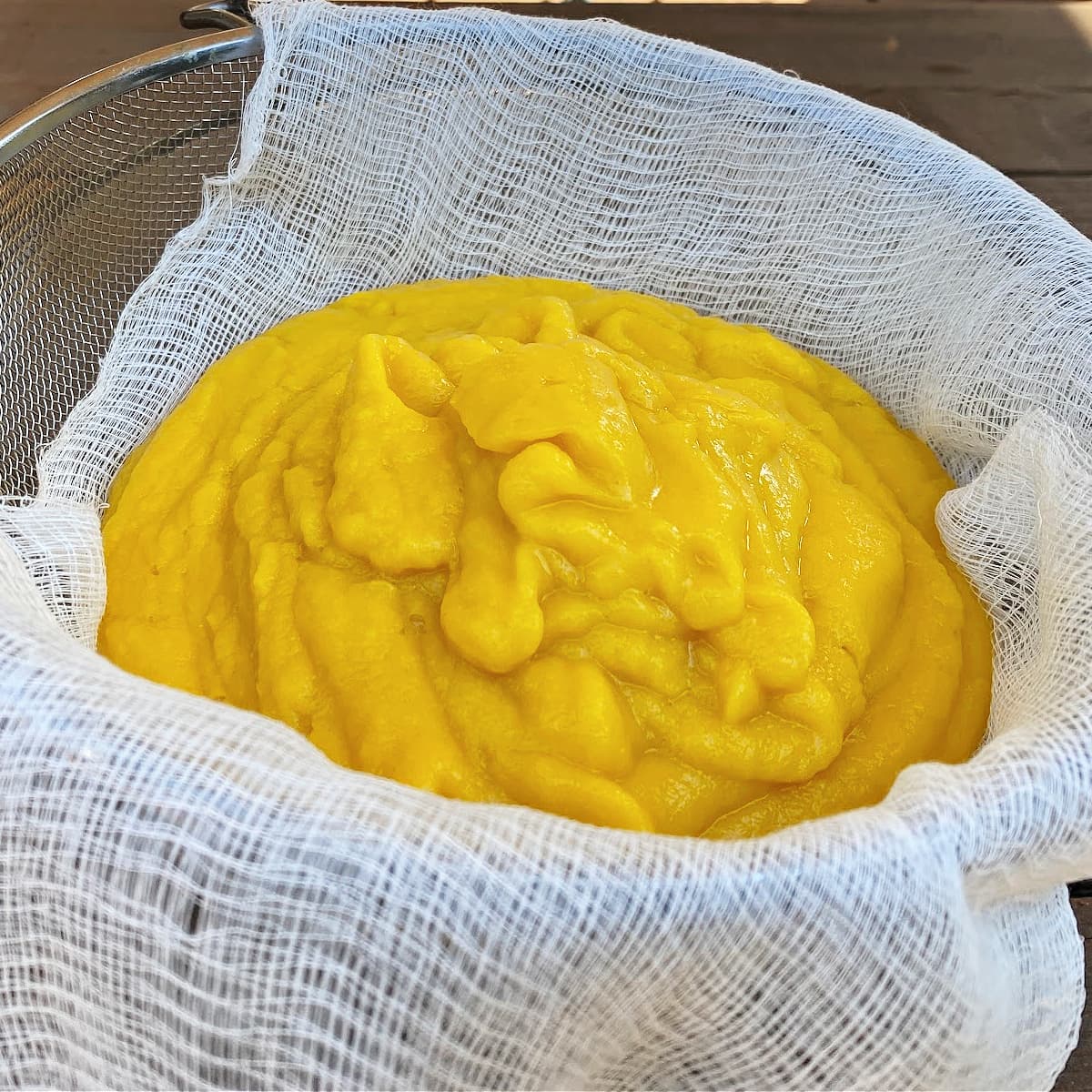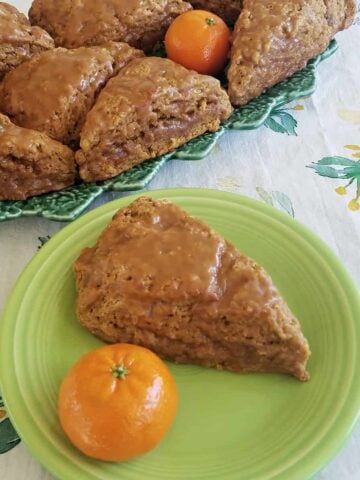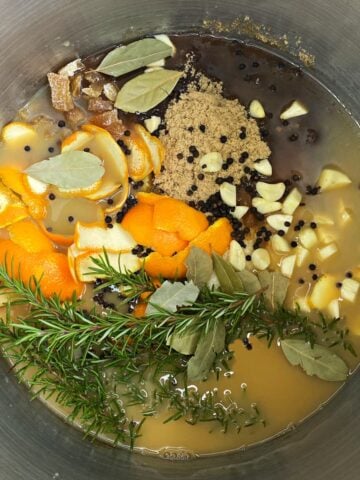With a smooth, velvety texture and rich flavor more delicate than canned, this Homemade Pumpkin Puree recipe is perfect for all your fall baking. Use fresh pumpkins or your choice of winter squashes.

Jump to:
Why Make Your Own Pumpkin Puree?
Canned pumpkin is admittedly more convenient; it's ready to go as soon as you take off the can lid. It is dependably "nostalgia-orange," and the flavor is constant from one can to the next. But if you have 20 minutes to spare, making your own pumpkin puree can be a game-changer.
There are two primary reasons to make your own pumpkin puree. First, in doing so, you can control the ingredients, allowing you to make your puree free of additives, preservatives, and excess sugars.

The second reason is flavor. In my experience, homemade pumpkin puree is generally richer, sweeter, and more delicate than canned. Moreover, the home-crafted flavor adds a personal touch that, especially to a holiday baker, can feel deeply gratifying. You can even make it using different squashes, to complement whatever recipe you plan to use it for.

The color of the puree varies somewhat depending on the squashes used, but it generally has a lighter color, and a sweeter, more delicate flavor.
The Best Pumpkin for Pie
After making many batches of homemade pumpkin puree over the years, my top pick for the best pumpkin for pie (and almost everything else) isn't actually a pumpkin at all: it's a red kuri squash.
Red kuri squash, also known as Hokkaido pumpkin, has vibrant, golden yellow flesh, and striking flame-orange skin. Its flesh has a sweet, nutty flavor that intensifies when roasted, yielding a rich, aromatic puree perfect for any sweet or savory recipe that calls for pumpkin puree.
Pie pumpkins (i.e., sugar pumpkins), with flesh far sweeter and less stringy than their bigger Jack-o'-lantern cousins, are another excellent choice. Pie pumpkins usually weigh about 2-7 pounds, with popular varieties including Cinderella, Sweet Sugar Pie, Small Sugar, and Orange Smoothie. Look for signs that say “sugar pumpkin” or “pie pumpkin” at stores or farmers' markets.
In addition to pie pumpkins, many other winter squashes also make delicious pumpkin puree. Varieties with a similar texture and sweetness to pumpkin include acorn, butternut, buttercup, honeynut, and Ambercup squashes.
You can make homemade pumpkin puree with one kind of squash, or use a variety for more complex puree flavor.
How to Make Pumpkin Puree
Preheat oven to 350°F (175°C). Line a baking sheet with parchment or a silicone mat.
Cut squashes in half and clean out the seeds. You can leave the halves intact, or cut them in smaller chunks. It isn't necessary to peel the squashes before roasting.
Tip: Safely cutting squashes can be tricky. Follow these links for how to cut:
Brush the exposed surfaces of the pumpkin chunks with olive oil, and sprinkle with a pinch of kosher salt.
Place the pumpkin pieces flesh side down on the parchment-covered baking sheet.
FYI: The pumpkin puree in these images was made using Sugar Pie pumpkins.

Bake squashes until tender; 40-70 minutes.
Hint: How long this step takes is dependent on the variety of squash, and how thick and dense it is. Generally, a 3-pound sugar pumpkin, for example, will take about an hour.

Check for doneness by piercing the skin with a fork: it should give easily, and the flesh should be very tender. It's fine if there are browned spots on the pumpkin flesh.
Remove the cooked pumpkin from the oven and allow it to cool for at least 15 minutes, or until it is cool enough to handle safely.

Use a large metal serving spoon, scrap the pumpkin flesh from the skin. Put the squash into a food processor or large blender cup.

Add just enough water to the cooked pumpkin to allow the blades to work it down. The amount of water needed will vary. Puree until the pumpkin is smooth and silky.

If your puree is watery, strain it through a cheesecloth-lined sieve before using or storing. For baking, you want it to be roughly the same consistency as canned pumpkin.

Storage
For ease of use, we suggest storing pumpkin puree in 1- or 2-cup quantities.
Refrigerator: Pour prepared pumpkin puree into canning jars or food-safe plastic containers. Refrigerate for up to a week.
Freezer: Pour in canning jars or plastic freezer containers, leaving ½-inch headspace. Allow the pumpkin puree to cool completely on the counter.
Pumpkin puree can be frozen for up to a year. Allow frozen pumpkin to thaw at room temperature or in the refrigerator before using.
Ways to Use Pumpkin Puree
There are countless ways to use pumpkin puree! Here are a few of our favorite ideas:
- Toss it into a creamy Pumpkin Pasta.
- Bake a Triple Ginger Pumpkin Pie or a loaf of Old-fashioned Pumpkin Gingerbread.
- Make a batch of Pumpkin Butter.
- Blend a Peachy Pumpkin Smoothie.

Want More Free Recipes?
Subscribe to our newsletter to get family-friendly recipes and cozy living ideas in your inbox each week!
Find us on Instagram, Pinterest, and Facebook, too.
If you enjoyed making pumpkin puree, you might like making other basic ingredients at home, like enchilada sauce, hearty chicken stock, oven-roasted garlic, and homemade pumpkin spice.

Homemade Pumpkin Puree
Equipment
- 1 rimmed baking sheet or roasting pan
- 1 Parchment Paper or silicone baking mat
- 1 food processor or blender
- 1 wire strainer
- 1 cheese cloth
Ingredients
- 5 pound whole pumpkin or other winter squash
- olive oil as needed
- kosher salt optional, as needed
- water as needed
Instructions
- Preheat oven to 350°F (175°C). Line a baking sheet with parchment or a silicone mat.Cut squashes in half and clean out the seeds. You can leave the halves intact, or cut them in smaller chunks. It isn't necessary to peel the squashes before roasting.
- Brush the exposed surfaces of the pumpkin chunks with olive oil, and sprinkle with a pinch of kosher salt.Place the pumpkin pieces flesh side down on the parchment-covered baking sheet.
- Bake squashes until tender; 40-70 minutes. How long this step takes is totally dependent on the variety of squash, and how thick and dense it is. Generally, a 3-pound sugar pumpkin, for example, will take about an hour.
- Check for doneness by piercing the skin with a fork: it should give easily, and the flesh should be very tender. It's fine if there are browned spots on the pumpkin flesh.
- Remove the cooked pumpkin from the oven and allow it to cool for at least 15 minutes, or until it is cool enough to handle safely.
- Use a large metal serving spoon, scrap the pumpkin flesh from the skin. Put the squash into a food processor or large blender cup.
- Add just enough water to the cooked pumpkin to allow the blades to work it down. The amount of water needed will vary. Puree until the pumpkin is smooth and silky.
- If your puree is watery, strain it through a cheesecloth-lined sieve before using or storing. For baking, you want it to be roughly the same consistency as canned pumpkin.
Notes
The Best Squashes to Use for Pumpkin Puree
- Red kuri squash
- Pie pumpkins (i.e., sugar pumpkins)
- Butternut
- Buttercup
- Honeynut
- Acorn
Nutrition
This website provides approximate nutrition information for convenience and as a courtesy only. You are solely responsible for ensuring that any nutritional information provided is accurate, complete, and useful.
Love it? Pin it! If you love this homemade pumpkin puree recipe, make sure that you don’t lose it! Pin it to your favorite Pinterest recipe board before you go!

Thank you for visiting the Good Hearted Woman. Remember to bookmark this site, and come back soon!











Gina says
This is so much better than store bought! This will be my go-to for baking for the holidays!
Gianne says
It's incredibly simple to make and tastes so much better than store-bought. The rich, creamy texture and natural sweetness make it the perfect addition to all my favorite fall recipes. Yum!
Sara Welch says
I have used this recipe in so many recipes and it does not disappoint! Easy, sweet and savory!
Anjali says
This homemade pumpkin puree was so much more flavorful and rich than store bought pumpkin puree, and it was so easy to make too!
Andrea says
I have so many recipes that call for pumpkin puree. This fresh and easy to make pumpkin puree will definitely come in handy.
Kristine says
Followed your instructions to a T and the puree came out wonderfully! I haven't used it in any recipes yet, but it's all jarred up and ready to go. Thank you, this was super helpful!